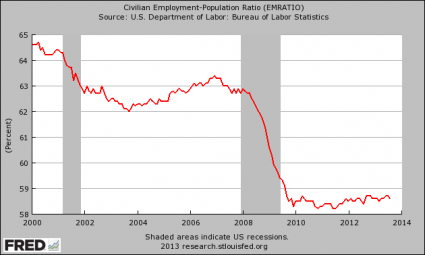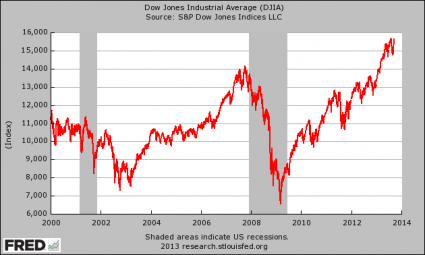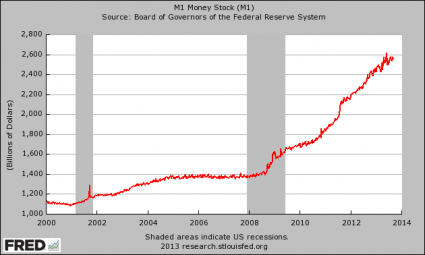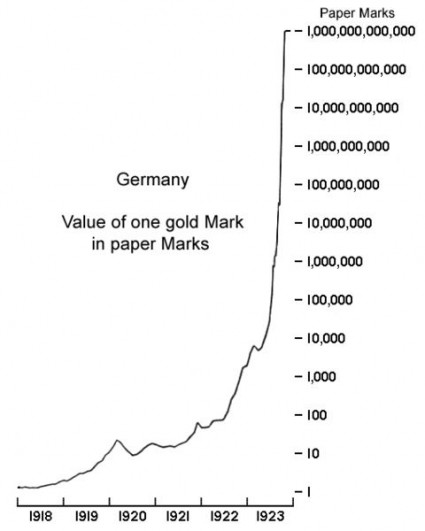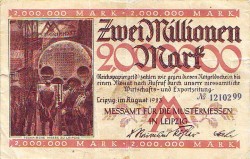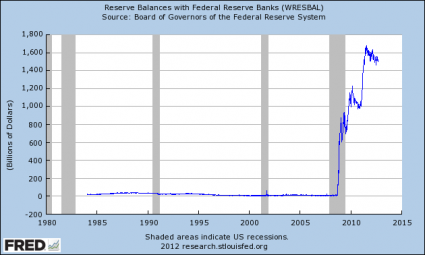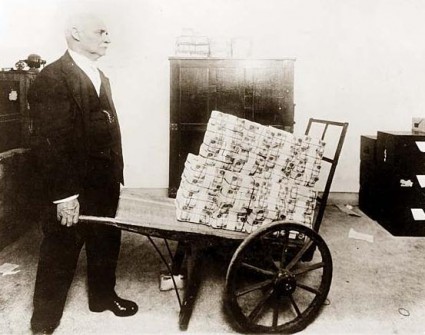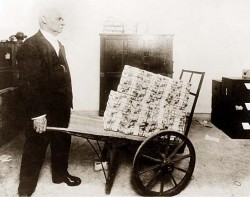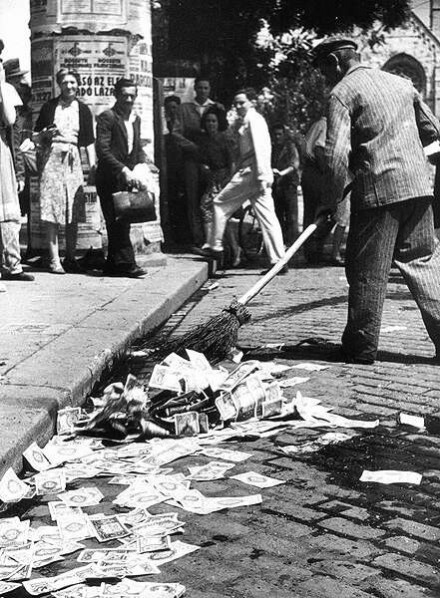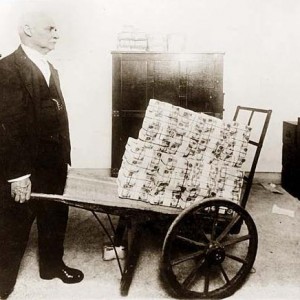 There is a reason why every fiat currency in the history of the world has eventually failed. At some point, those issuing fiat currencies always find themselves giving in to the temptation to wildly print more money. Sometimes, the motivation for doing this is good. When an economy is really struggling, those that have been entrusted with the management of that economy can easily fall for the lie that things would be better if people just had “more money”. Today, the Federal Reserve finds itself faced with a scenario that is very similar to what the Weimar Republic was facing nearly 100 years ago. Like the Weimar Republic, the U.S. economy is also struggling and like the Weimar Republic, the U.S. government is absolutely drowning in debt. Unfortunately, the Federal Reserve has decided to adopt the same solution that the Weimar Republic chose. The Federal Reserve is recklessly printing money out of thin air, and in the short-term some positive things have come out of it. But quantitative easing worked for the Weimar Republic for a little while too. At first, more money caused economic activity to increase and unemployment was low. But all of that money printing destroyed faith in German currency and in the German financial system and ultimately Germany experienced an economic meltdown that the world is still talking about today. This is the path that the Federal Reserve is taking America down, but most Americans have absolutely no idea what is happening.
There is a reason why every fiat currency in the history of the world has eventually failed. At some point, those issuing fiat currencies always find themselves giving in to the temptation to wildly print more money. Sometimes, the motivation for doing this is good. When an economy is really struggling, those that have been entrusted with the management of that economy can easily fall for the lie that things would be better if people just had “more money”. Today, the Federal Reserve finds itself faced with a scenario that is very similar to what the Weimar Republic was facing nearly 100 years ago. Like the Weimar Republic, the U.S. economy is also struggling and like the Weimar Republic, the U.S. government is absolutely drowning in debt. Unfortunately, the Federal Reserve has decided to adopt the same solution that the Weimar Republic chose. The Federal Reserve is recklessly printing money out of thin air, and in the short-term some positive things have come out of it. But quantitative easing worked for the Weimar Republic for a little while too. At first, more money caused economic activity to increase and unemployment was low. But all of that money printing destroyed faith in German currency and in the German financial system and ultimately Germany experienced an economic meltdown that the world is still talking about today. This is the path that the Federal Reserve is taking America down, but most Americans have absolutely no idea what is happening.
It is really easy to start printing money, but it is incredibly hard to stop. Like any addict, the Fed is promising that they can quit at any time, but this month they refused to even start tapering their money printing a little bit. The behavior of the Fed is so shameful that even CNBC is comparing it to a drug addict at this point…
The danger with addictions is they tend to become increasingly compulsive. That might be one moral of this week’s events.
A few days ago, expectations were sky-high that the Federal Reserve was about to reduce its current $85 billion monthly bond purchases. But then the Fed blinked, partly because it is worried that markets have already over-reacted to the mere thought of a policy shift.
Faced with a choice of curbing the addiction or providing more hits of the QE drug, in other words, it chose the latter.
So why won’t the Fed cut back on the reckless money printing?
Well, as Peter Schiff recently noted, Fed officials seem to be convinced that any “tapering” could result in the bursting of the massive financial bubbles that they have created…
The Fed understands, as the market seems not to, that the current “recovery” could not survive without continuation of massive monetary stimulus. Mainstream economists have mistaken the symptoms of the Fed’s monetary expansion, most notably rising stock and real estate prices, as signs of real and sustainable growth. But the current asset price bubbles have nothing to do with the real economy. To the contrary, they are setting up for a painful correction that will likely be worse than the one we experienced five years ago.
As I have written about previously, the Federal Reserve is usually very careful not to do anything which will hurt the short-term interests of the financial markets and the big banks.
But at this point the Fed is caught in a trap. If it continues to pump, the financial bubbles that it has created will get even worse. If it stops, those bubbles will burst. But as Doug Kass noted recently, it is inevitable that these financial bubbles will burst at some point one way or another…
“Getting in was easy. Getting out—not so much. The Fed is trapped and can’t end tapering or else the bond and stock markets will blow up. The longer this continues the bigger the inevitable burst.”
In essence, we can have disaster now or disaster later.
But most Americans don’t care much about what is happening on Wall Street. They just want economic conditions to get better for them and for those around them. And to this day, the mainstream media continues to sell quantitative easing to the American people as an “economic stimulus” program by the Federal Reserve.
So has quantitative easing actually been good for the U.S. economy?
Not really.
For example, while the Fed has been recklessly printing money out of thin air, household incomes have actually been going down for five years in a row…
What about employment?
Don’t more Americans have jobs now?
Actually, that is not the case at all. Posted below is a chart that shows how the percentage of working age Americans with a job has changed since the year 2000. As you can see, the employment to population ratio fell from about 63 percent before the last recession down to underneath 59 percent at the end of 2009 and it has stayed there ever since…
So where is the “employment recovery”?
Can you point it out to me? Because I have been staring at this chart for a long time and I still can’t find it.
So if quantitative easing has not been good for average Americans, who has it been good for?
The wealthy, of course.
Just check out what billionaire hedge fund manager Stanley Druckenmiller told CNBC about quantitative easing the other day…
“This is fantastic for every rich person,” he said Thursday, a day after the Fed’s stunning decision to delay tightening its monetary policy. “This is the biggest redistribution of wealth from the middle class and the poor to the rich ever.”
“Who owns assets—the rich, the billionaires. You think Warren Buffett hates this stuff? You think I hate this stuff? I had a very good day yesterday.”
Druckenmiller, whose net worth is estimated at more than $2 billion, said that the implication of the Fed’s policy is that the rich will spend their wealth and create jobs—essentially betting on “trickle-down economics.”
“I mean, maybe this trickle-down monetary policy that gives money to billionaires and hopefully we go spend it is going to work,” he said. “But it hasn’t worked for five years.”
Sadly, Druckenmiller is exactly correct.
Since the end of the last recession, the Dow has been on an unprecedented tear…
Of course these stock prices have nothing to do with economic reality at this point, but for the moment those that are making giant piles of cash on Wall Street don’t really care.
Sadly, what very few people seem to understand is that what the Fed is doing is going to absolutely destroy confidence in our currency and in our financial system in the long-term. Yeah, many investors have been raking in huge gobs of cash right now, but in the long run this is going to be bad for everybody.
We have now entered a money printing spiral from which there is no easy exit. According to Graham Summers, the Fed has “crossed the Rubicon” and we are now “in the End Game”…
If tapering even $10-15 billion per month from $85 billion month QE programs would damage the economy, then we’re all up you know what creek without a paddle.
Put it this way… here we are, five years after 2008, and the Fed is stating point blank that the economy would absolutely collapse if it spent any less than $85 billion per month. This admission has proven just how long ago we crossed the Rubicon. We’re already in the End Game. Period.
Most Americans don’t really understand what quantitative easing is, and most don’t really try to understand it because “quantitative easing” sounds very complicated.
But it really isn’t that complicated.
The Federal Reserve is creating gigantic mountains of money out of thin air every month, and the Fed is using all of that newly created money to buy government debt and mortgage-backed securities. Over the past several years, the value of the financial securities that the Fed has accumulated is greater than the total amount of publicly held debt that the U.S. government accumulated from the presidency of George Washington though the end of the presidency of Bill Clinton…
The same day that the Federal Reserve’s Federal Open Market Committee announced last week that the Fed would continue to buy $40 billion in mortgage-backed securities (MBS) and $45 billion in U.S. Treasury securities per month, the Fed also released its latest weekly accounting sheet indicating that it had already accumulated more Treasuries and MBS than the total value of the publicly held U.S. government debt amassed by all U.S. presidents from George Washington though Bill Clinton.
To say that this is a desperate move by the Fed would be a massive understatement. We have never seen anything like this before in U.S. history.
And look at what all of this wild money printing has done to our money supply…
In many ways, the chart above is reminiscent of what the Weimar Republic did during the early years of their hyperinflationary spiral…
Just like the Weimar Republic, our money supply is beginning to grow at an exponential pace.
So far, complete and total disaster has not struck, so most people think that everything must be okay.
But it is not.
In a previous article, I included an outstanding illustration from Simon Black that I think would be extremely helpful here as well…
Let’s say you’re at a party in a small apartment that’s about 500 square feet in size. Then suddenly, at 11pm, a pipe bursts, starting a trickle into the living room.
Aside from the petty annoyance, would you feel like you were in danger? Probably not. This is a linear problem– the rate at which the water is leaking is more or less constant, so the guests can keep partying through the night without worry.
But let’s assume that it’s an exponential leak.
At first, there’s just one drop of water. But each minute, the rate doubles. So by 11:01pm, there’s 2 drops. By 11:02, 4 drops. And so forth.
By 11:27pm, there’s only six inches of standing water. Yet by 11:31pm, just four minutes later, the entire room is under nearly 8 feet of water. And the party’s over.
For nearly half an hour, it all seemed safe and manageable. People had all the time in the world to leave, right up until the bitter end. 11:27, 11:28, 11:29. Then it all went from benign to deadly in a matter of minutes.
Are you starting to get the picture?
What the Federal Reserve is doing is systematically destroying the U.S. dollar, and the rest of the world is starting to take notice.
Why should they continue to lend us trillions of dollars at super low interest rates when we are exploding the size of our money supply?
It is simply not rational for other nations to continue to lend us money at less than 3 percent a year when the real rate of inflation is somewhere around 8 to 10 percent and reckless money printing by the Fed threatens to greatly accelerate the devaluation of our currency.
When QE first started, the added demand for U.S. government debt by the Federal Reserve helped drive long-term interest rates down to record low levels.
But in the long-term, the only rational response by all other buyers of U.S. government debt will be to demand a much higher rate of return because of the rapid devaluation of U.S. currency.
So QE drives down long-term interest rates in the short-term, but in the long-term the only rational direction for long-term interest rates to go is much, much higher and in recent months we have already started to see this.
The only way that the Fed can stop this is by increasing the amount of quantitative easing.
Right now, the Fed is buying roughly half a trillion dollars worth of U.S. Treasuries a year, but the U.S. government issues close to a trillion dollars of new debt and must roll over about 3 trillion dollars of existing debt each year.
If the Federal Reserve eventually decides to buy all of the debt, then interest rates won’t be a major problem. But if the Fed goes that far our financial system would be regarded as a total joke by the remainder of the globe and we would reach hyperinflation much more rapidly.
If the Federal Reserve stops buying debt completely, the financial bubbles that they have created will burst and we will rapidly be facing a financial crisis even worse than what we experienced back in 2008.
But almost whatever the Fed does at this point, the rest of the world will probably continue to start to move away from the U.S. dollar as the de facto reserve currency of the planet. This move is just beginning, but it is going to have major implications for us in the years ahead. This is a topic that I will be addressing extensively in future articles.
Most of the debate about quantitative easing has focused on the impact that it will have on the U.S. economy in the short-term.
That is a huge mistake.
Of much greatest importance is what quantitative easing means for the long-term.
The rest of the world is losing confidence in the U.S. dollar and in U.S. debt because of the reckless money printing that the Fed has been doing.
But we desperately need the rest of the world to use “the petrodollar” and to lend us the money that we need to pay our bills.
As the rest of the planet starts to reject the U.S. dollar and starts to demand a much higher rate of return to lend us money, the U.S. economy is going to experience a tremendous amount of pain.
It is hard to put into words how foolish the Federal Reserve has been. The Fed is systematically destroying what was once the strongest financial system in the world, and in the end we are all going to pay the price.

